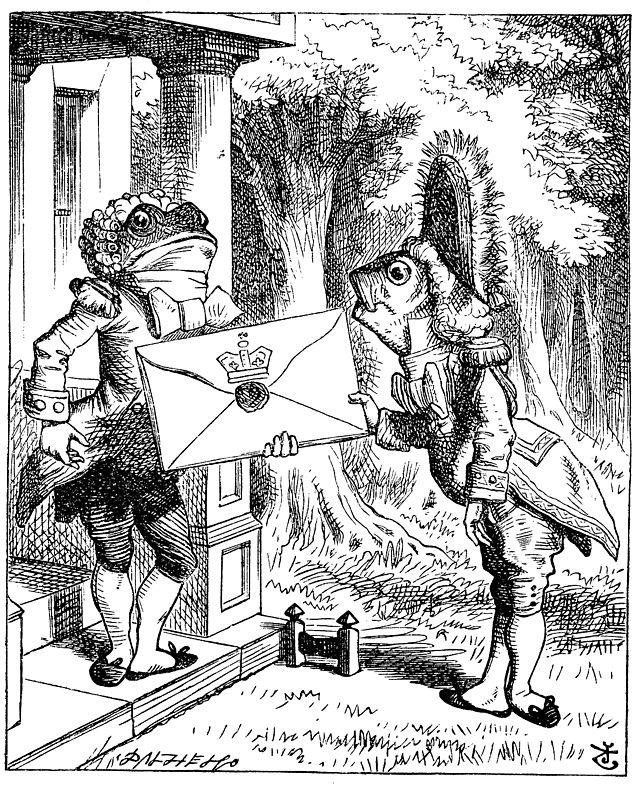This case presents a collection of animals in Victorian illustrated literature that just so happen to be dressed to in human clothes. What do their outfits say about them, and why are they dressed this way? We can learn much about the values and culture of the Victorians by looking at what George Cruikshank calls "social zoology."
John Tenniel, "The Fish Footman and the Frog Footman," from Alice's Adventures in Wonderland, by Lewis Carroll, 1865. This plate shows us two different animals from two different kingdoms, a frog and and a fish, drawn as bipedal creatures in formal wear. Both animals are made equal by the similarity of their outfits; they both wear trousers, coats with epaulets, and powder wigs, which indicate status but in this case shows their employers are wealthy and/or socially important. Their uniforms also resemble 19th-century British Army uniforms because of their epaulets, length, and buttoned cuffs. Carroll's text lets us know that these two water-dwellers are servants of the Queen in this story, confirming our suspicions that they are working in a household of high status. They work directly for the crown, putting them at a similar level to the Queen's guards. Carroll's choice of animals is also very interesting-- in many pieces of literature birds are often messengers, but instead he chose a fish and a frog. While neither are particularly known for their speed, both animals are known to very effectivey work and travel in groups.
John Tenniel, "The White Rabbit," from Alice's Adventures in Wonderland, by Lewis Carroll, 1865. This is a classic image of the White Rabbit, one of the most famous characters to come out of Wonderland. In this image, the White Rabbit, Esquire is dressed in a jacket and vest, but more importantly, he is checking a pocket watch. The Victorian era marked the beginning of the timesheet in the workplace and the clock-in clock-out system. Work environments became much more supervised, which led to a more stressful culture that centered around timeliness for the first time. The White Rabbit's pocketwatch and overall obsession with time is a social commentary on this newly emerging work culture in Victorian England. The White Rabbit's other items of clothing, the coat and vest, are both typical of Victorian men's fashion. His outfit is not as fancy as the uniforms of Fish and Frog footmen, but his clothing indicates the dress of a respectable gentleman, who can afford a nice coat. A lower-class character would have donned looser fitting clothing and perhaps a hat. The White Rabbit's white coloring is yet another marker of respectability, with the color representing cleanliness and purity in an age that still looked to the Bible for morality and rules.
George Cruikshank, " A Horrible Bore in the Company, The Lion of the Party!," from George Cruikshank's Table-Book, 1845. This piece by George Cruikshank is yet another playful example of using men's fashion in the Victorian Era to comment satirically on society. A boar and a lion appear, respectively, at the top and bottom of this illustration. The Boar is said to be a 'bore,' a word play implying that this animal is bad at party-going while the Lion is a success. The two animals are dressed almost identically, but the Lion wears white more formal white pants. The Boar, who wears dark pants, seems to be socializing poorly amongst the human socialites, who are glaring at him with looks of disgust. The Lion, on the other hand, carries himself with poise and draws positve attention from the other guests.
Beatrix Potter, "Mrs. Tiggy-Winkle," from The Tale of Mrs. Tiggy-Winkle, 1905. While many personified animals in Victorian literature seem to be males, there are a few staple female character who have also been memorably dressed up. Known for her loyalty to the naturalism of her animal characters, Beatrix Potter portays Mrs Tiggy-Winkle as a matronly woman while still having her appear as an authentic hedgehog. She is meant to resemble a washerwoman, and Potter achieves this effect by creating a domestic aesthetic with her outfit. Her attire is representative of what a working woman wore during this era. She dons a bonnet, which covers her hair and represents respectability. Her little quills poke through the bonnet, reminding us of her species. Mrs. Tiggy-Winkle also wears a long sleeved petticoat with an apron. Mrs. Tiggy-Winkle's petticoat is pink, which adds to her welcoming appearance. She's very roundly shaped and overall kind-looking, making her the perfect mother-like animal character of Victorian illustration.





